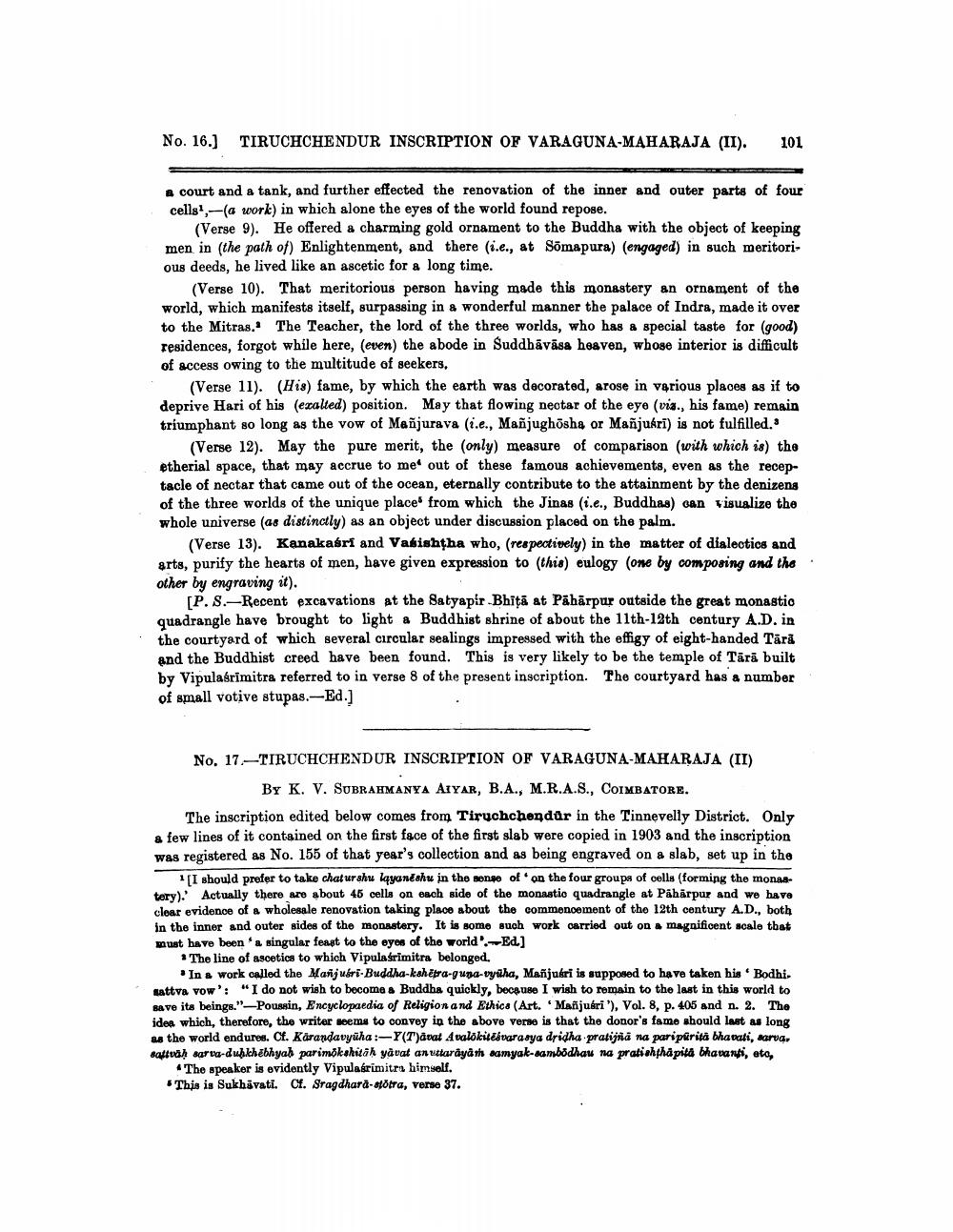________________
No. 16.)
TIRUCHCHENDUR INSCRIPTION OF VARAGUNA-MAHARAJA (II).
101
a court and a tank, and further effected the renovation of the inner and outer parts of four cells",-(a work) in which alone the eyes of the world found repose.
(Verse 9). He offered a charming gold ornament to the Buddha with the object of keeping men in the path of) Enlightenment, and there (i.e., at Somapura) (engaged) in such meritorious deeds, he lived like an ascetic for a long time.
(Verse 10). That meritorious person having made this monastery an ornament of the world, which manifests itself, surpassing in a wonderful manner the palace of Indra, made it over to the Mitras.' The Teacher, the lord of the three worlds, who has a special taste for (good) residences, forgot while here, (even) the abode in Suddhāvāsa heaven, whose interior is difficult of access owing to the multitude of seekers.
(Verse 11). (His) fame, by which the earth was decorated, arose in various places as if to deprive Hari of his (exalted) position. May that flowing neotar of the eye (via., his fame) remain triumphant so long as the vow of Mañjurava (i.e., Mañughosha or Mañjukri) is not fulfilled.
(Verse 12). May the pure merit, the (only) measure of comparison (with which is) the etherial space, that may accrue to me out of these famous achievements, even as the receptacle of nectar that came out of the ocean, eternally contribute to the attainment by the denizens of the three worlds of the unique place from which the Jinas (i.e., Buddhas) can visualize the whole universe (as distinctly) as an object under discussion placed on the palm.
(Verse 13). Kanakasri and Vabishtha who, (respectively) in the matter of dialectics and arts, purify the hearts of men, have given expression to (this) eulogy (one by composing and the other by engraving it).
[P. S.-Recent excavations at the Satyapir Bhītā at Pāhārpur outside the great monastio quadrangle have brought to light a Buddhist shrine of about the 11th-18th century A.D. in the courtyard of which several circular sealings impressed with the effigy of eight-handed Tárå and the Buddhist creed have been found. This is very likely to be the temple of Tärā built by Vipulasrimitra referred to in verse 8 of the present inscription. The courtyard has a number of small votive stupas.-Ed.]
No. 17.-TIRUCHCHENDUR INSCRIPTION OF VARAGUNA-MAHARAJA (II)
BY K. V. SUBRAHMANYA AIYAR, B.A., M.R.A.S., COIMBATORE. The inscription edited below comes from Tiruchchendur in the Tinnevelly District. Only a few lines of it contained on the first face of the first slab were copied in 1903 and the inscription was registered as No. 155 of that year's collection and as being engraved on a slab, set up in the
I should prefer to take chaturshu layančahu in the sense of on the four groups of cells (forming the monastery). Actually there are about 45 cells on each side of the monastic quadrangle at Pahārpur and we have clear evidence of a wholesale renovation taking place about the commencement of the 12th century A.D., both in the inner and outer sides of the monastery. It is some such work carried out on a magnificent scale that must have been a singular feast to the eyes of the world' Ed]
* The line of ascetics to which Vipulasrimitra belonged.
In a work called the Manjusri-Buddha-kshetra-guna-vytiha, Mañjukri is supposed to have taken his 'Bodhi. sattva vow': "I do not wish to become a Buddha quickly, because I wish to remain to the last in this world to save its beings."-Poussin, Encyclopaedia of Religion and Ethics (Art. "Manjusri'), Vol. 8, p. 405 and n. 2. The idea which, therefore, the writer seems to convey in the above verse is that the donor's fame should last as long as the world endures. Cf. Karandavyūha :-Y(T)aval Avalokitesvarasya dridha pratijñā na paripuritā bhavati, sarva, sattvah sarva-duhkhēbhyah parimokshitäh yavat an uttarayath samyak-sambódhau na pratishthapita bhavanti, eto,
. The speaker is evidently Vipulasrimitra himself. This is Sukhävati. Cf. Sragdhara-stötra, verse 37.




